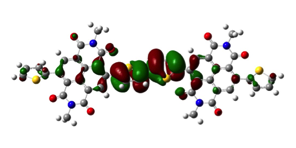Asymmetry in Mobility
The ease with which materials transport charge is a key factor in determining whether or not they will be useful in electronic applications such as solar cells and transistors. This is especially true with organic semiconductors that offer cheap, flexible alternatives to silicon and germanium. The intrinsic mobility of electrons and holes in an organic semiconductor should be equal, yet when it’s fabricated into devices, the electrons and holes exhibit a surprising asymmetry. Researchers have assumed this is because trapping sites collect charges and alter the flow, but in Physical Review B, Gert-Jan Wetzelaer at the University of Groningen, Netherlands, and colleagues report experiments and calculations showing that electron transport can be inherently superior because of the way charges hop along the polymer chains and modify the molecular structure.
Wetzelaer et al. studied a polymer, trade-named Polyera ActivInk N2200, that was sandwiched between electrodes in diode and transistor structures for mobility measurements. They found that, contrary to expectations, the intrinsic mobility is different for holes and electrons. To understand this behavior, the authors carried out quantum-chemical calculations of charge transport through the polymer, focusing on the reorganization energy, which accounts for changes in molecular conformation and nuclear polarization, and the transfer integral, a measure of electronic coupling between sites.
The calculations showed that electrons have a lower reorganization energy and a higher transfer integral than holes in this material, meaning that electron mobility is intrinsically better. The results imply that finding polymers with the optimal molecular structure, rather than perfecting fabrication techniques, is the best route to obtaining ambipolar behavior in organic semiconductors. – David Voss





